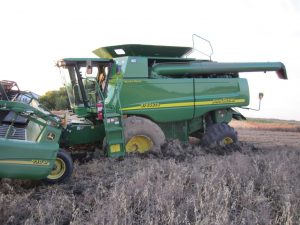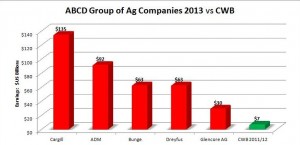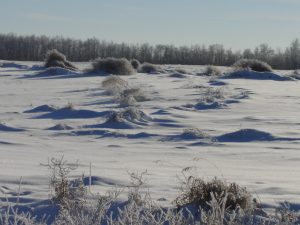(January 4, 2017) Like an old Queen once said of another year, 2016 was an Annus horribilis for most prairie farmers. Bumper crops ended up snowed under or degraded by excessive rainfall. The pull-type combine made a comeback with many farmers adding a four wheel drive tractor on standby to rescue combines stuck in the mud. But hey, when not stuck in the mud or buried in snow, the yields were great.
However, the big story of 2016 was the shrinking influence and market power of prairie farmers compared to the ever larger cartels they face on both the input and marketing side.
The merger of major agro-chemical seed companies like Bayer and Monsanto and the take-over of Syngenta by the Chinese Government’s “ChemChina,” come to mind. Not to mention fertilizer makers Potash Corp and Agrium agreed to a merger which would make that sector into one dominated by just three corporations surpassing the market dominance of the big four grain trade companies (ABCD group).
The government of Saudi Arabia and Bunge, one of the ABCD group, continued their building binge on the prairies and perhaps in Vancouver as well – using the Canadian Wheat Board (CWB) equity taken from farmers and effectively gifted to them by the Harper government.
Of course the loonies who killed the market power of prairie farmers by killing the CWB did not sit on their laurels this past year. They have managed to push both the Alberta NDP’s Rachel Notley and the photogenic Liberal Justin Trudeau into continuing to implement many of the Harper-era agricultural policies designed to make the world safe for big grain and chemical companies and decidedly less friendly for farmers.
While tout le monde in Alberta was all a quiver about the NDP carbon tax, the Notley government was ignoring calls to review provincially mandated financing of Alberta-based astro-turf groups aggressively pushing the introduction of genetically modified wheat on the Federal stage. Not to mention the Alberta Wheat Commission is already on record as demanding that our grain grading standards be harmonized with the much lower quality standards used by our global rivals. If this happens it will end one of the few remaining advantages prairie farmers have in the international grain market.
Not to be outdone, the Trudeau government followed the same bad advice from the industry captured Canola Council of Canada regarding Chinese canola grading concerns by lowering our dockage standards to match those of other nations. This amounted to giving the Chinese an automatic price discount while making it much easier for the multinational grain handling companies to pick and choose the source of canola for sale to China based on which farm community is most desperate to sell. This guarantees the Chinese and other customers the lowest possible price while throwing away our unique Canadian advantage, paid for by prairie farmers, for producing the cleanest and highest quality product on the planet.
This deeply foolish move gives the impression that Prime Minister Trudeau’s apparently shallow understanding of agriculture was taken advantage of by slick industry insiders manipulating a Federal Agriculture Minister from a province not noted for its grain production.
The beginning of 2016 saw the NDP adopt something called the “Leap Manifesto” for discussion. This collection of generalities and feel good statements called for, among other things, more local food production.
So it is appropriate to note that the holiday season of 2016 is likely to be the high point of local food production and consumption in Canada. To date all the milk, eggs, chickens, and turkeys are still grown on (mostly) western Canadian farms thanks to farmer-controlled marketing Boards. Given the Liberal endorsement of the Canada-EU Trade Agreement (CETA) and the peculiar lack of attention by the Alberta NDP, this will soon be a thing of the past.
In fact, as was said here some time ago, the disappearance of Canadian-grown grain is already starting. For those of us west of Thunder Bay, all our wheat products, pasta, and almost all the beer still come from grain grown on prairie farms although from more centralized processing plants. But for those of you east of Thunder Bay, now that the farmer-run Canadian Wheat Board has been killed, your bread and pasta may well be partly or wholly made with wheat from the Ukraine.
However, there are some bright spots in the grain outlook. In spite of the best efforts of the Alberta Wheat, Barley, and Canola commissions to see the control of the grains genome and plant breeding turned over to the big agro-chemical-seed companies, when given a vote, farmers have been firmly resistant. Another bright spot is many of the farmers who were paid by a major agro-chemical-seed company in the 1990s to spy on their neighbours and report about individuals questioning the value of introducing genetically modified wheat have retired.
The Trudeau Liberals have also brought some real sunny ways to the Federal scene. Research scientists have had their muzzles removed, and some key environmental research projects have been revived. More immediately important, Ottawa appears to have restored funding to agricultural research. And so far at least, the Minister of Transport has resisted the calls for further deregulating the railways coming from the same groups who want GM wheat.
So it would be fair to hope that Ottawa will continue to restore what Harper destroyed in Agriculture at the Federal level, and unlike what appears to be happening south of the medicine line, 2017 could well be a year of rebuilding the public trust in Canada. Time will tell.




